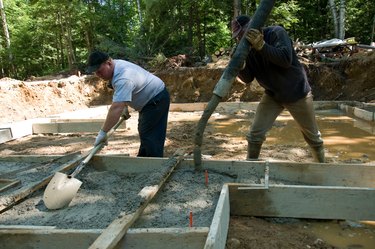
Slab foundations are often seen in warm climates where shallow frost lines do not require pouring deep foundation footings and stem walls. They're also beneficial for constructing patio-type homes that do not features basements. Because the plumber has no access for installing pipes below the concrete, preliminary plumbing takes place before the foundation contractor pours the slab.
Main Sewer Line
Video of the Day
The main sewer line runs beneath the future slab on a gravity-flow system. The pipe gradually descends until it ties into the public sewer main that may run behind the houses in an easement or beneath the street in front of the house. If it's a rural home, the main sewer line runs to a septic tank. The main sewer line is the deepest of all the drain lines, all of which attach to the main sewer line beneath the slab.
Video of the Day
Drain Lines
Provisions for draining every fixture are made before the contractor pours the slab. The plumber runs individual drainpipes for future sinks, utility drains, tubs and showers. As each of these drain pipes connects to the main sewer line, it must have its own gradual descent, or "fall," to allow gray water and waste materials to flow through the pipe and into the sewer line.
Rough-In
Before the concrete trucks come, the contractor fills in the area over the network of plumbing pipes and drain lines with compacted sand. At this point, you will no longer see the horizontal drainpipes and the main sewer line, but you will see the "stubs" that extend vertically out of the sand. Where the blueprints call for a tub or shower, the contractor builds a small box around the stub. The box, about 1 foot square, contains soil or sand and prevents concrete from covering the drain stub.
During the Pour
When the contractor pours the slab, the concrete covers everything except for the box that contains the shower stub. Later, when the plumber installs the shower or tub, she'll dig away the sand and hook the shower drain to the drain stub. Because drains on showers and tubs require the installation of P-traps beneath floor level, the contractor does not pour concrete around these roughed-in stubs.
Water Supply Lines
Lines that supply water to the fixtures run above grade, through stud walls. These lines are narrower and made from copper or polyvinyl chloride (PVC). Once the builder constructs the rough frame of the house, the plumber installs the water supply lines. After the wiring, ducting and drywall are in place, the plumber comes back one more time to hook up the water supply lines and the drain stubs to the sinks, tubs and showers.